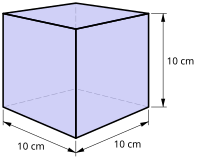Microlitre
| Litre | |
|---|---|

One litre is the volume of a
cube with 10 cm sides |
|
| Unit system | SI derived unit |
| Unit of | Volume |
| Symbol | l (ℓ) or L |
| In SI base units: | 1 L = 10−3m3 |
The litre (international spelling) or liter (American spelling) (SI symbols L or l, commonly, but incorrectly, abbreviated as ltr) is an SI accepted metric system unit of volume equal to 1 cubic decimetre (dm3), 1,000 cubic centimetres (cm3) or 1/1,000 cubic metre. A cubic decimetre (or litre) occupies a volume of 10×10×10 centimetres (see figure) and is thus equal to one-thousandth of a cubic metre.
The original French metric system used the litre as a base unit. The word litre is derived from an older French unit, the litron, whose name came from Greek — where it was a unit of weight, not volume — via Latin, and which equalled approximately 0.831 litres. The litre was also used in several subsequent versions of the metric system and is accepted for use with the SI, although not an official SI unit — the SI unit of volume is the cubic metre (m3). The spelling used by the International Bureau of Weights and Measures is "litre", a spelling which is shared by almost all English-speaking countries. The less common spelling of "liter" is more predominantly used in American English.
One litre of liquid water has a mass of almost exactly one kilogram, because the kilogram was originally defined in 1795 as one cubic decimetre of water at the temperature of melting ice. Subsequent redefinitions of the metre and kilogram mean that this relationship is no longer exact.
...
Wikipedia
